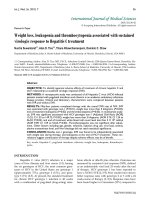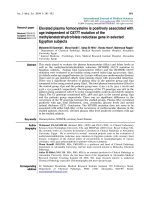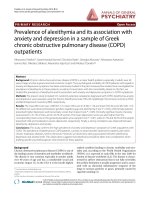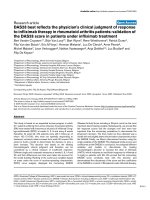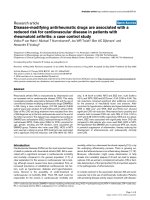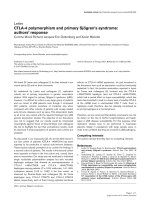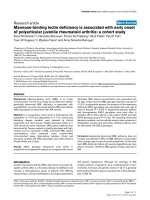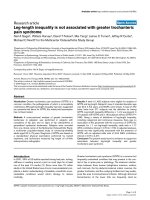Báo cáo y học: "Weight loss, leukopenia and thrombocytopenia associated with sustained virologic response to Hepatitis C treatmen"
Bạn đang xem bản rút gọn của tài liệu. Xem và tải ngay bản đầy đủ của tài liệu tại đây (224.58 KB, 7 trang )
Int. J. Med. Sci. 2010, 7
36
I
I
n
n
t
t
e
e
r
r
n
n
a
a
t
t
i
i
o
o
n
n
a
a
l
l
J
J
o
o
u
u
r
r
n
n
a
a
l
l
o
o
f
f
M
M
e
e
d
d
i
i
c
c
a
a
l
l
S
S
c
c
i
i
e
e
n
n
c
c
e
e
s
s
2010; 7(1):36-42
© Ivyspring International Publisher. All rights reserved
Research Paper
Weight loss, leukopenia and thrombocytopenia associated with sustained
virologic response to Hepatitis C treatment
Nuntra Suwantarat
, Alan D. Tice
, Thana Khawcharoenporn, Dominic C. Chow
Department of Medicine, John A. Burns School of Medicine, University of Hawaii, Honolulu, Hawaii, USA 96813.
Corresponding Author: Alan D. Tice, MD, FACP., Infections Limited Hawaii; 1286 Queen Emma Street, Honolulu, Ha-
waii 96813. E-mail: ; Telephone: +1-808-373-3488; Fax: +1-808-536-2024. Co-Corresponding Author:
Nuntra Suwantarat, MD., Department of Medicine, John A. Burns School of Medicine, University of Hawaii, 1356 Lusitana
Street, 7th Floor, Honolulu, HI 96813. E-mail: ; Telephone: +1-808- 586-2910; Fax: +1-808-586-7486
Received: 2009.10.19; Accepted: 2010.01.21; Published: 2010.01.22
Abstract
OBJECTIVE: To identify apparent adverse effects of treatment of chronic hepatitis C and
their relationship to sustained virologic response (SVR).
METHODS: A retrospective study was conducted of all Hepatitis C virus (HCV)-infected
patients treated with pegylated interferon and ribavirin in an academic ambulatory infectious
disease practice. Clinical and laboratory characteristics were compared between patients
with SVR and without SVR.
RESULTS: Fifty-four patients completed therapy with the overall SVR rate of 76%. SVR
was associated with genotype non-1 (P=0.01), weight loss more than 5 kilograms (P=0.04),
end of treatment leukopenia (P=0.02) and thrombocytopenia (P=0.05). In multivariate analy-
sis, SVR was significant associated with HCV genotype non-1 (Adjusted Odd Ratio [AOR]
15.22; CI 1.55 to 149.72; P=0.02), weight loss more than 5 kilograms, (AOR 5.74; CI 1.24 to
26.32; P=0.04), and end of treatment white blood cell count level less than 3 X 10
3
cells/µl
(AOR 9.09; CI 1.59 to 52.63; P=0.02). Thrombocytopenia was not significant after adjust-
ment. Other factors including age, gender, ethnicity, injection drug use, viral load, anemia,
alanine transaminase level, and liver histology did not reach statistical significance.
CONCLUSION: Besides non-1 genotype, SVR was found to be independently associated
with weight loss during therapy, and leukopenia at the end of HCV treatment. These cor-
relations suggest continuation of therapy despite adverse effects, may be of benefit.
Key words: Hepatitis C, pegylated interferon, ribavirin, weight loss, leukopenia, thrombocyto-
penia.
INTRODUCTION
Hepatitis C virus (HCV) infection is a major
cause of liver diseases and liver cancer (1-3).
Among
the six genotypes of HCV, the most common geno-
types of HCV in the United States are genotype 1
(approximately 75%), genotype 2 (15%), and geno-
type 3 (7%) (2-5). At present, the standard treatment
for chronic HCV genotype 1 infection is 48 weeks
with a combination of pegylated (long-acting) inter-
feron alfa-2a or alfa-2b plus ribavirin. Outcomes are
measured by sustained viral response (SVR), defined
as an undetectable viral load 24 weeks after the end
of therapy. HCV genotype 1 has been reported to
have a 54-56% SVR (2, 6-9).
Prior studies have shown
better response rates with genotype 2 or 3 with a 24
week-course of therapy (2, 8,9). Response rates have
been found higher in Caucasians (52%) compared to
Int. J. Med. Sci. 2010, 7
37
African-Americans (28%) (2). Response rates are re-
ported lower with initial levels of HCV RNA
>600,000 IU/ml, male gender, high body weight, and
advanced liver fibrosis (11-17).
Recent studies have
also shown a poorer response to treatment associated
independently with HCV genotype1 infection but a
better response with weight loss (18). Limited
knowledge exists regarding the influence of
on-treatment factors during therapy. The purpose of
our analysis was to identify clinical, biological, vi-
rological and histological predictive factors that may
be helpful in guiding decisions during therapy, and
for counseling patients about outcomes.
MATERIALS AND METHODS
Study population. We conducted a retrospective
cohort study of 54 adults (age ≥ 18 years) patients
who were diagnosed with HCV infection and com-
pleted treatment with pegylated interferon plus ri-
bavirin through an academic ambulatory infectious
disease practice from January 2004 to December 2007.
The study was approved by the University of Hawaii
Committee on Human Studies (CHS # 1541). Patients
infected with HCV genotype 1 completed a 48
week-course with once weekly injections of pegylated
interferon alfa-2a or alfa 2b (180 μg) plus ribavirin
(1000 or 1200 mg/day in divided dose) for 48 weeks.
Patients infected with HCV genotypes 2 or 3 com-
pleted a 24 week-course with once weekly injections
of pegylated interferon alfa-2a (180 μg) plus ribavirin
(800 mg/day in divided doses). SVR rates were
measured at 24 weeks after the end of therapy. Inter-
feron dosing was not adjusted but ribavirin occasion-
ally was. Hematology growth factors were occasion-
ally used but not consistently.
Study design and definitions. The study patients
were identified from the clinic’s medical records us-
ing the International Statistical Classification of
Diseases and Related Health Problems (ICD) code of
070.44 and 070.54. During the period of study, 78 pa-
tients started on therapy. Twenty four patients were
not included in the study analysis due to fail to com-
plete treatment and evaluation. Of these, 13 failed to
return for follow-up, 6 stopped because of adverse
effects, 3 for poor response, and 2 because of death.
Finally, a total of 54 charts were reviewed in the pa-
tients who completed therapy and returned for fol-
low-up at 24 weeks after treatment. Information on
demographic characteristics, co-morbid conditions,
genotypes of HCV, laboratory data, treatment, and
follow-up data were collected by using a study data
collection form. SVR was indicated by undetectable
HCV RNA at 24 weeks after therapy with combined
pegylated interferon alfa-2a or alfa-2b plus ribavirin.
Genotypes of HCV were defined using the Bayer
TRUGENE HCV Genotyping Test. Serum concentra-
tion of HCV RNA was determined shortly before
study and at 24 weeks after complete course of treat-
ment (treatment duration: 48 weeks in genotype 1
and 24 weeks in genotype 2 or 3) by the COBAST
(TaqMan) test, which has a limit of detection of 28
IU/mL. Body weight measurement and laboratory
data were collected and compared at the beginning
and at the end of therapy. The Knodell scoring sys-
tem for liver biopsy (obtained at baseline) result was
used as the indicator of histologic activity.
Statistical analysis. Descriptive statistics were
produced comparing SVR versus non-SVR group.
Categorical variables were compared using the Pear-
son’s χ
2
or Fisher’s exact test, as appropriate. The dis-
tribution of continuous data was evaluated by the
O’Brien test for homogenicity of variances. When
necessary, an appropriate normalizing or variance
stabilizing transformation was applied. Analysis of
variance was used to compare groups. Cut-offs of
continuous data was determined by evaluating the
median results of the groups and deciding among the
investigators clinical importance. From the data,
clinically relevant cut-offs determined by the investi-
gators were as follows: for weight loss (more than 5
kilograms.), leukopenia (WBC less than 3x10
3
cells/µl)
and thrombocytopenia (platelets less than 1x 10
5
cells/µl). Logistic regression and multivariate analy-
sis were performed to identify independent predic-
tors for SVR. Statistical significance was considered
with P value of 0.05. Odds ratio (OR) with 95% con-
fidence interval (CI) was reported in categorical data.
All statistical analyses were conducted using SPSS for
Window software, version 15.0 (SPSS Inc, Chicago,
IL).
RESULTS
A total of 54 medical records of patients who
completed HCV therapy with follow-up viral load
result at 24 weeks were reviewed. The majority of the
study population was male (67%) and Caucasian
(57%) with the mean age of 52.5 years (Table 1). Fifty
six percent were infected with genotype 1, 16% with
genotype 2 and 28% with genotype 3. Clinical char-
acteristics, relevant laboratory data and liver biopsy
results of all patients are shown in Table 1. The major
risk factors for acquiring HCV infection were related
to injection drug use and tattooing. Mild and moder-
ate liver inflammation determined by Knodell score
was presented in the majority of patients while cir-
rhosis was rarely observed. A total of 22 patients had
liver fibrosis: portal fibrosis was the most common
(n=11, 50%), followed by septal fibrosis (n=4, 18%),
Int. J. Med. Sci. 2010, 7
38
bridging fibrosis (n=4, 18%), periportal fibrosis, and
only one patient with cirrhosis pattern (n=1, 5%).
Forty-one percent of the patient population had a
history of alcohol abuse and 35% had underlying
psychiatric problems. Concomitant psychiatric dis-
orders among this patient population included de-
pression (38%), anxiety (18%), schizophrenia (6%)
and bipolar disorder (3%). Underlying medical prob-
lems included hypertension (15%) and diabetes mel-
litus (DM) (14%).
Demographics, clinical and laboratory data of
patients (percent and means) were compared be-
tween patients with SVR and without SVR as shown
in Table 2. All continuous variables were normally
distributed and did not require log transformation.
SVR was significantly affected by genotype non-1
(P=0.01) as well as low white blood cell (WBC) count
(leukopenia) at the end of treatment (P=0.02) com-
pared to patients without SVR. Moreover, low plate-
let count (thrombocytopenia) at the end of treatment
was associated with SVR (P=0.05). Age, ethnicity,
gender, drug abuse, and histology were not signifi-
cantly associated with SVR. To allow for clinical ap-
plicability, logistic regression with clinical cut-offs in
the significant relevant covariants, found in the linear
regression models, were performed. Laboratory
characteristics and categorical variables for the pre-
dictors of SVR were compared by using logistic re-
gression and multivariate analysis (categorical data)
as displayed in Table 3. In multivariate analysis, SVR
was significant associated with HCV genotype non-1
(Adjusted Odd Ratio [AOR] 15.22; CI 1.55 to 149.72;
P=0.02), weight loss more than 5 kilograms, (AOR
5.74; CI 1.24 to 26.32; P=0.04), and end of treatment
white blood cell count level less than 3 X 10
3
cells/µl
(AOR 9.09; CI 1.59 to 52.63; P=0.02). Thrombocyto-
penia was not significant after adjustment. Other fac-
tors including age, gender, ethnicity, injection drug
use, viral load, anemia, alanine transaminase level,
and liver histology and did not reach statistical sig-
nificance.
Table 1: Baseline demographic, clinical characteristics and laboratory data of the study population
Characteristics
Total, n = 54
Male gender, n (%) 36 (67)
Ethnicity, n (%)
Caucasian 31 (57)
Asian 10 (19)
Hispanic 7 (13)
Hawaiian 6 (11)
Others 3 (6)
Age, years, mean ± SD 52.5±5.8
HCV genotypes, n (%)
Genotype 1 30 (56)
Genotype 2 9 (16)
Genotype 3 15 (28)
Weight, kilograms, mean ± SD 85.0± 19.1
BMI, kilograms/m
2
, mean ± SD 28.2±5.5
Baseline HCV RNA (x 10
6
IU/mL ± SD) 6.45±13.4
HCV RNA > 600,000 IU/mL, n (%) 47 (87)
ALT >90 U/L, n (%) 45 (83)
Total bilirubin, mg/dlL, mean ± SD 1.0±0.5
Serum albumin, g/dl, mean ± SD 3.9±0.3
Liver biopsy results; n = 38
Knodell score, mean ± SD 8.0 ± 3.2
Minimal inflammation (≤4), n (%) 4 (11)
Mild inflammation (5-8), n (%) 18 (47)
Moderate inflammation (9-12), n (%) 14 (37)
Marked inflammation (≥13), n (%) 2 (5)
Risk factors for acquiring HCV infection, n (%)
Injection drug use 38 (70)
Tattooing 41 (76)
Sexual partners with HCV infection 10 (19)
Blood transfusion 5 (9)
Int. J. Med. Sci. 2010, 7
39
History of cocaine use, n (%) 22 (41)
History of alcohol abuse, n (%) 22 (41)
History of methamphetamine use, n (%) 2 (4)
HIV co infection, n (%) 3 (6)
Underlying psychiatric disorders (depression, bipolar disorder, schizophrenia and anxiety), n (%) 19 (35)
Underlying medical conditions (diabetes mellitus, hypertension, others), n (%)
28 (52)
Abbreviations: ALT = alanine transminase; BMI = body mass index; HCV = hepatitis C virus; HIV = human immunodeficiency virus; RNA
= ribonucleic acid; SD = standard deviation.
Table 2: Comparison of demographics, clinical characteristics and laboratory data between patients with and without
sustained virological response (SVR).
Characteristics Patients with SVR
(n=41 )
Patients without SVR (n=13) P-Value
Male gender, n, (%) 30 (73) 6 (46) 0.11
Caucasians, n (%) 23 (56) 8 (62) 0.94
Age <50 years, n (%) 25 (60) 10 (77) 0.24
Genotype 1, n (%) 18 (44) 12 (92) 0.01*
Risk factors for acquiring HCV infection, n (%)
Injection drug use 26 (63) 12 (92) 0.28
Blood transfusion 4 (10) 1 (8) 0.21
Baseline characteristic and risk factors
Alcohol abuse, n (%) 14 (47) 8 (62) 0.22
Cocaine use, n (%) 13 (32) 7 (54) 0.15
Methamphetamine use, n (%) 0 (0) 2 (15) 0.15
HIV co-infection, n (%) 1 (3) 2 (15) 0.47
Psychiatric disorders, n (%) 14 (34) 5 (38) 0.75
Knodell score < 11, n (%) 16 (64)
a
10 (77)
b
0.07
HCV RNA (x10
6
IU/mL, mean ± SD) 4.6±5.6 8.3±15.6 0.22
Weight (kilograms, mean ± SD) 92.1±22.2 77.9±16.0 0.10
Baseline laboratory data
WBC (X 10
3
cells/µl, mean ±SD) 6.6±3.1 6.8±2.8 0.97
Hemoglobin (g/dl, mean ± SD) 15.3±0.9 14.8±1.2 0.91
Platelet (X 10
5
cells/µl, mean ± SD) 184.0±93.8 239.7±99.7 0.14
ALT (U/L, mean ± SD) 78.5±70.5 63.6±28.8 0.31
Total bilirubin (g/dl, mean ± SD) 1.1±0.7 0.8±0.2 0.47
Albumin (g/dl, mean ± SD) 3.8±0.4 4.0±0.2 0.10
End of treatment laboratory data
WBC (X 10
3
cells/µl, mean ± SD) 2.9 ±1.1 3.6±0.9 0.02*
Hemoglobin (g/dl, mean ± SD) 11.8 ± 1.8 11.7±1.5 0.42
Platelet (X 10
6
cells/µl, mean ± SD) 122.4 ± 96.8 207.2±86.5 0.05*
ALT (U/L, mean ± SD) 35.3 ± 26.8 36.6±28.1 0.60
Total bilirubin (g/dl, ) mean ± SD) 1.4 ± 1.4 0.8± 0.3 0.13
Albumin (g/dl, mean ± SD) 3.8 ±0.3 3.8±0.5 0.95
Clinically significance relevantce characteristic and laboratory data
Weight loss > 5 Kilograms, n (%) 29 (71) 5 (38) 0.04*
End of treatment WBC count less than 3 X 10
3
cells/µl 34 (83) 3 (23) 0.01*
End of treatment platelet count less than 1X 10
5
cells/µl 36 (88) 7(54) 0.06
Note: * Statistical significant. Biopsy results;
a
total n for SVR = 25;
b
total n for non SVR =13.
Abbreviations: ALT = alanine transminase; HCV = hepatitis C virus; RNA = ribonucleic acid; SD = standard deviation; SVR = sustained
virological response; WBC = white blood cell count.
Int. J. Med. Sci. 2010, 7
40
Table 3: Logistic regression and multivariate analysis for the predictors of SVR (Clinical significance relevance characteristic
and laboratory data)
Variables
OR
(95% CI)
P-value
Adjusted
#
OR
(95% CI)
P-value
Age < 50 year
2.5
(0.57-10)
0.24
1.38
(0.23-8.33)
0.73
Genotype Non-1
15.33
(1.82-129.18)
0.01*
15.22
(1.55-149.72)
0.02*
Weight loss more than 5 kilograms 3.86
(1.05-14.82)
0.04*
5.74
(1.24-26.32)
0.04*
End of treatment WBC count less than 3 X 10
3
cells/µl 9.52
(1.86-50.00)
0.01*
9.09
(1.59-52.63)
0.02*
End of treatment platelet count less than 1X 10
5
cells/µl 6.9
(0.8-5.9)
0.06 2.43
(0.13-45.45)
0.51
Note: * Statistical significant.
#
Model adjusted with all table variables.
Abbreviation; CI = confidence interval; OR = odds ratio; SVR = sustained virological response; WBC = white blood cell.
DISCUSSION
The overall rate of response was 76% compara-
ble with those reported in the previous US studies of
55%. Responses were better for both genotype 1 (56%
vs 52%) and others (96% vs 81-84%).
2
Our study
strongly indicated that being infected with HCV
genotype 1 was associated with treatment failure. The
higher treatment response in our study compared to
the US literatures may have occurred from differ-
ences in our demographic population. Our study had
less African Americans (only 1 patient), and a lower
prevalence of HCV genotype 1 and HIV co –infection.
Higher response rates among Asians have been noted
before. This may be related to the IL28B gene poly-
morphism as it is apparently associated with higher
response to treatment among Asian Americans pa-
tients compared to Caucasians, Hispanics and Afri-
can Americans, respectively (19).
In our study, the patients with SVR had signifi-
cant weight loss compared to those without SVR. The
association between body weight, weight loss and
SVR is controversial. Some previous studies showed
that initial body weight is an independent risk factor
for HCV treatment failure, and weight reduction was
associated with treatment success (10, 20). However,
other studies demonstrated that weight loss did not
improve the treatment outcomes (15, 21). It is known
that interferon therapy is associated with weight loss,
but the mechanism and pathophysiology are still un-
clear. The reasons for weight loss among the study
population are unclear. Many patients complained of
loss of appetite or ate less related to the fatigue.
Studies suggest that interferon decreases appetite via
induction of tumor necrosis factors (TNF), the level of
leptin, insulin and cytokines but findings are not con-
sistent (21-24). Alternatively, several studies showed
that TNF levels were not increased during interferon
therapy and postulated other mechanisms of weight
loss including changes in level of leptin and insulin
which affect glucose metabolism (21, 22).
In our stud-
ies, weight loss usually began within the first few
dosages of interferon treatment. It was also associated
with fatigue, nausea, vomiting. The weight loss was
usually sustained during therapy or gradually pro-
gressed. On the follow-up after complete treatment,
patients usually gained weight but did not achieve
their baseline bodyweight.
In our study, patients with SVR had signifi-
cantly lower WBC and platelet count at the end of
treatment compared to those without SVR. These
findings suggested that patients who developed leu-
kopenia and/or thrombocytopenia during the inter-
feron treatment responded well to the therapy and
these side effects, if not severe, may not be indications
for withholding or reducing the dose of the treat-
ment. We hypothesized that the greater cytopenia is a
marker for greater TNF activity in a specific treat-
ment recipient which translates into greater SVR.
Common side effects of interferon treatment that
need to be monitored during the therapy are anemia,
thrombocytopenia and leukopenia (25-29). These side
effects may prevent physicians from continuing their
patients on interferon therapy or reducing dosage (28,
29). A comparison of outcome by the approach of re-
ducing interferon and/or ribavirin versus use of
growth factors to stimulate promotion of white blood
cell or red blood cell or platelet counts has not been
done but is clearly needed. We believe that the dif-
ferences in magnitude of interferon effects on indi-
vidual pharmacokinetics, pharmocodynamics, and
genetic determination of interferon susceptibility may
play an important role in each patient’s treatment
response and side effect experience.
Our patients had a high rate of mental illnesses
and social problems because of our open referral sys-
